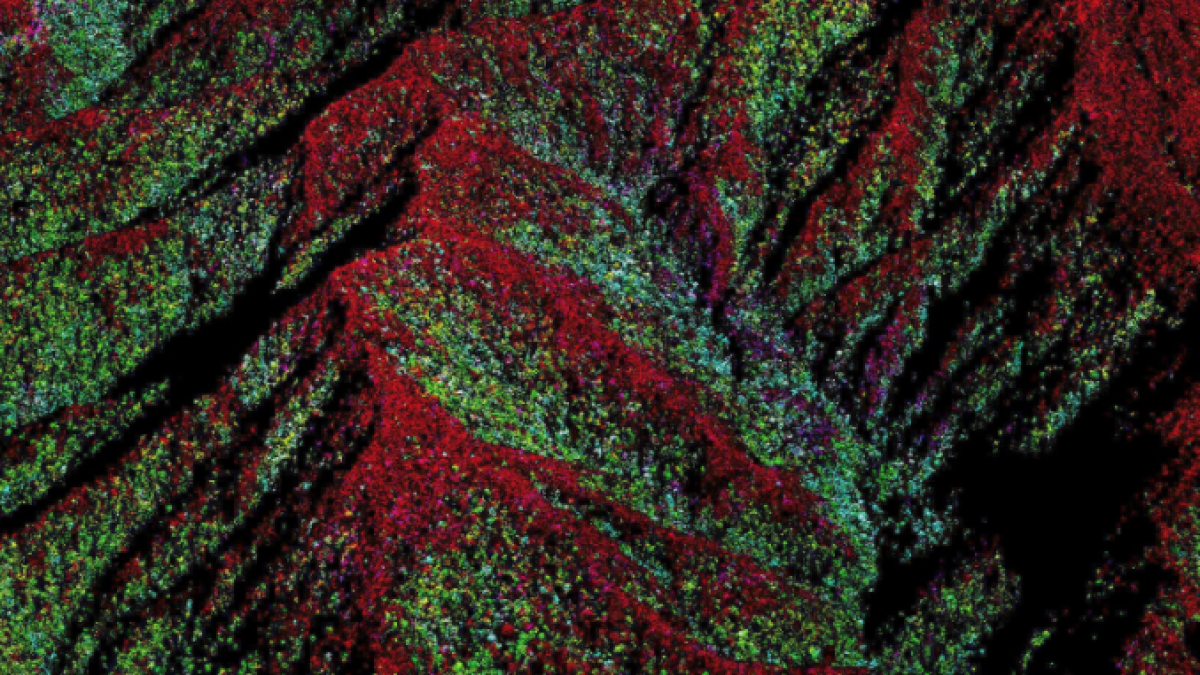Airborne science discovers complex geomorphic controls on Bornean forests

Leaf nutrient concentrations for Mount Kinabalu in Malaysian Borneo: lowest (red) to mid-range (green) to highest (blue-purple). Photo courtesy Global Airborne Observatory, ASU Center for Global Discovery and Conservation Science
Tropical forests contain some of the most biodiverse and dynamic ecosystems in the world. Environmental conditions such as precipitation, temperature and soils shape the biota of the landscape. This influence is especially noticeable when comparing the towering trees found in low-elevation forests to the hardier, shorter ones found at the top of tropical mountains. Together, these factors create an ever-changing and heterogeneous ecosystem, with each niche harboring different species of uniquely adapted trees.
Scientists have sought to understand the links between geology (the rock types that soils originate from), biogeochemistry (feedbacks between environmental conditions, nutrient cycling and plants), biodiversity (the variety of life in an ecosystem) and biogeography (how trees are distributed across a landscape) to paint a more complete picture of how life coevolved with our planet. Now, in a new study published Wednesday in Ecology Letters, researchers from Stanford University and Arizona State University used maps of leaf chemistry, high-resolution topography data and computer models to reveal new insights into the processes governing these complex interactions.
“We wanted to explore how long-term processes that shape the Earth’s surface also act to control the organization of ecosystems across landscapes," said Dana Chadwick, lead author of the study. "Understanding these organizing processes requires the integration of concepts from across disciplines. The purpose of this study was to combine high-resolution airborne remote sensing datasets that contain information on both ecosystems and the morphology of landscapes to understand how the two are interrelated on this iconic tropical mountain."
The study analyzed data from Mount Kinabalu in Malaysian Borneo, a 4,095-meter high mountain harboring a wide diversity of trees across topographically varied terrain. As tropical rains drench the mountain’s surface, elevation differences between its shallow slopes and steep peaks create imbalances in soil erosion rates — generally, the steeper the hill, the faster the rain rushes down its surface, taking soil with it. Soils carry nutrients needed by plants to grow, and erosion contributes to the distribution of these plant-required nutrients. Some areas become nutrient-rich and others become nutrient-poor, influencing the kinds of trees that can grow there. Adding to this dynamic process, some soil types are more or less prone to erosion than others depending upon their geological origins, and can also contain more nutrients plants need than others.
To overcome limitations of previous studies conducted in tropical mountains at a local scale, the researchers used maps created by ASU’s Global Airborne Observatory to collect large-scale data across 32 watersheds and at elevations ranging from 700 meters to 2,800 meters. The maps included the concentrations of nutrients in the tropical forest canopy as well as the structure and architecture of the trees. This provided the researchers an unprecedented look at the forests of Mount Kinabalu and its remote complex terrain.
“Although we originally deployed our airborne observatory to Borneo for conservation impact, such as the new protected area now under development, the opportunity to discover all-new patterns of biodiversity also presented itself in ultraremote areas like Mount Kinabalu,” said Greg Asner, author of the study and director of ASU’s Center for Global Discovery and Conservation Science.
The chemical maps revealed that leaves from trees contained different amounts of nutrients depending upon both the elevation and geology of its environment. Along hillslopes, from ridge to valley, trees contain more nutrients while their ability to capture and utilize sunlight also increases. The researchers found that this trend was significantly impacted by changing erosion rates, highlighting the important role erosion plays in distributing fresh nutrients to the soil.
“The discovery of such strong and beautifully complex geologic control on forest composition gives us new insight into the fundamental makeup of Bornean forests, in ways that inspire even more exploration,” Asner added.
Funding for this study was provided by the John D. and Catherine T. MacArthur Foundation, Avatar Alliance Foundation, the Rainforest Trust, the United Nations Development Programme, William R. Hearst III and a National Science Foundation EAR Postdoctoral Fellowship.
More Science and technology

ASU professor honored with prestigious award for being a cybersecurity trailblazer
At first, he thought it was a drill.On Sept. 11, 2001, Gail-Joon Ahn sat in a conference room in Fort Meade, Maryland.…

Training stellar students to secure semiconductors
In the wetlands of King’s Bay, Georgia, the sail of a nuclear-powered Trident II Submarine laden with sophisticated computer…

ASU startup Crystal Sonic wins Natcast pitch competition
Crystal Sonic, an Arizona State University startup, won first place and $25,000 at the 2024 Natcast Startup Pitch Competition at…